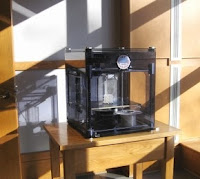 |
| 3D Printing at Rodgers Library |
Like a computer printer, a
3D printer processes directions from your computer and “prints out” those instructions. However, instead of ink on paper it prints in plastic and silicon – for those curious, even chocolate and frosting. Libraries have a central role to play in this emergent technology. In its position as a nexus for research on university campuses, academic libraries should function as universal access points for these technologies.
By offering 3D scanning technology, libraries can use this technology internally for archival purposes whie also opportunities for self-education and lifelong learning for its students and faculty. For instance, Engineering and architecture students can create and manipulate 3-D designs in programs like AutoCAD in order to print inexpensive prototype versions of their designs, which they can review and rework as they see fit. Can you imagine the possibilities of this technology? What libraries are innovative in the area of 3D printing? Here are some early adopters:
Dalhousie Libraries - NextEngine 3D scanner and a MakerBot Replicator 3D
Dalhousie Libraries combines the NextEngine 3D scanner and MakerBot Replicator 3D printer. Since a higher end 3D scanner was already available in the engineering department, the NextEngine 3D scanner was a good starting point for other Faculties interested in experimenting with the technology. The NextEngine 3D scanner also allowed the various museums, archives, and the art gallery on campus to digitize various items from their physical collections.
Fayetteville Free Library - the Fab Lab
The Fayetteville Free Library, in Fayetteville New York, has opened the
FFL Fab Lab where they offer diverse DIY (do-it-yourself) programming ranging from creative writing, book making, 3D printing and have free access to 3D printing technology.
3D Printing Studio at The University of Alabama Libraries
UA Libraries uses a Bits from Bytes (BFB) 3D Touch double head printer for its 3D Printing Studio. In its workshops, workshops, users have came from various departments such as Art, Engineering, Chemistry, Physics, Biology and English. Studio location, implementation of a two-step training process, and independent user operation have all contributed to making the
UA Libraries 3D Printing Studio
a successful pilot project.
Recommended Reading and Resources:
Groenendyk, Michael. "A Further Investigation into 3D Printing and 3D Scanning at the Dalhousie University Libraries: a Year Long Case Study." (2013). [
Link]
Heater, Brian. “The shape of things to come: A consumer's guide to 3D printers.”
Endgadget. Jan 29th, 2013. [
Link]
Ratto, Matt, and Robert Ree. "Materializing information: 3D printing and social change."
First Monday 17.7 (2012). [
Link]
Scalfani, Vincent F., and Josh Sahib. "A Model for Managing 3D Printing Services in Academic Libraries."
Issues in Science and Technology Librarianship (2013). [
Link]
Tweney, Dylan. "DIY freaks flock to hackerspaces worldwide."
Wired, March, available at: www. wired. com/gadgetlab/2009/03/hackerspaces/(accessed September 24, 2012) (2009). [
Link]














